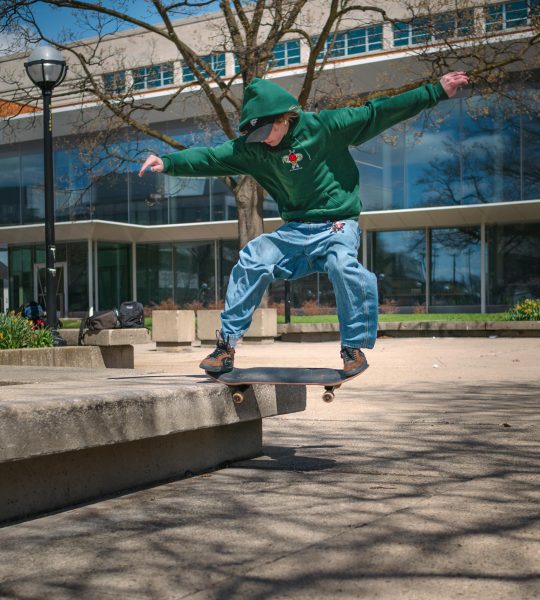Lost in the Gray
The sun was gone.
The gray sky was a thick tarp; smothering everything beneath it. There wasn’t a sliver of sunlight or a cloud in sight. The ground was slush, watery and tinted brown. The snow covering front lawns was patchy and at some spots even bare, exposing matted down grass.
What was this suffocating feeling so many people felt during the winter months?
Apparently, it’s called a seasonal affective disorder, or SAD — how ironic.
“I just wish I could hibernate all winter long,” Hannah Freeland said.
Freeland is a student-teacher at CHS and an undergraduate student at the University of Michigan. Curled up beneath layers of blankets on a frigid winter afternoon was the only place she wanted to be. Certainly not outside on campus in ten-degree weather and howling winds.
“When it’s so dark and gray, all my emotional energy is taken away,” Freeland said.
Although Freeland is not medically diagnosed with SAD, her mood does take a hit during the winter months.
SAD is a form of depression that occurs at the same time every year. It typically starts in the fall and continues into the winter months. However, the time frame can vary from person to person and some may experience SAD during the summer months.
SAD is estimated to affect ten million Americans and an additional 20% may have mild SAD, according to Psychology Today.
The winter blues can get to any one of us, too, not to be confused with SAD.
“There are different scales of feeling down. There are the blues, where you’re just not on your game for a while. Seasonal depression, on the other hand, spikes up during certain months and the winter weather doesn’t make it any easier,” Mikaela Melcher said, a CHS student who was formerly diagnosed with SAD at a young age and now is just affected by clinical depression.
To clarify: While general depression consists of episodes that can spike anytime throughout the year, SAD presents itself in seasonal patterns. It’s important to recognize that just because a depressive episode occurs in the winter, that does not automatically categorize it as SAD.
According to Health Essentials, “the winter blues, ” a milder variant of seasonal depression, is prevalent among those who live in colder climates. For people living in Michigan and Midwestern states, it wouldn’t be uncommon to have the occasional winter blues.
Clinical depression, whether it is non-seasonal major depression disorder or SAD, is often more debilitating.
“My friend is outwardly a very happy person. But she will take one step outside and you can just see her frown,” Arista Luong, CHS student said about her close friend. She explained that her friend deals with severe SAD and that she does everything she can to make it better.
“She doesn’t go to school a whole lot during the winter,” Luong said.
It is extremely frustrating for Luong to see her friend slip into such a dark place. She wants only the best for her and wished she would realize the toll it had on her grades and social life. This is a prime example of the crippling effects of SAD.
Luong and her friend eventually came to an agreement: if Luong sent her food, she would have to go to school for the rest of the week. Typically, Luong opts for Chipotle and will Postmate it early in the week.
It’s not always doom and gloom here in Michigan.
On rare occasions, we are reminded of its true beauty; bright blue skies and warm sun showers. Colors become more vibrant, thoughts become unclouded, feelings become stronger.
Between classes on nice days, Freeland savors her time walking across the Diag. She’ll look up at the sky and relish the feeling of the sun on her skin.
“I like to go for walks in the woods. . . , but I also try to enjoy the time when I’m walking between classes a bit more. Last week was the first time in a while that I heard birds in the morning. That sound definitely lifts my spirits,” Freeland said.
During those super cold, drab stretches, the only people seen on campus are already halfway inside the nearest building.
For some with more acute forms of SAD, getting out of bed in the deep of winter can be a rollercoaster of reluctance, dread, and despair. Even the simplest of tasks, like putting together an outfit consisting of anything other than sweats, or completing a straightforward homework assignment, can feel impossible for those affected by seasonal depression.
“It really showed in my grades,” Melcher said, “The first and fourth quarters of school were always my best, but during the winter, my grades dropped.”
That’s how Melcher realized that she was affected by seasonal depression. She continued to draw the lines between having a harder time getting out of bed in the winter and having SAD. Her school performance took a blow and she simply could not muster the interest to complete her assignments. She sat towards the back of the classroom, letting the teacher’s voice flow in one ear and out the other. Her body was there but her mind was in a haze.
“I want to do well, I really do. But I physically can’t sometimes,” Melcher added.
Melcher was not willing to sacrifice her mental health for the sake of completing a homework assignment; she knew the toll it could have on her. She was mindful of what her brain and body needed, but it took her a while to get to that point.
Melcher spent half of her life living down south, hopping around warm climate states. As a kid, she moved from San Diego to New Mexico to Hawaii. The predictability of the weather was something that made her happy. That is assuredly something we lack in Michigan.
“I would tell my friends about my depression and they’d say, ‘No you don’t [have it]. You’re always smiling, how could you have depression?’,” Melcher said. These interactions have made her cognizant of her feelings and she has now come to accept that some days are not as good as others.
We all must find ways to cope with whatever we are going through— whether it’s major depression or simply just an off day. We all need something, someone, or some way to just let it out.
“Doing small things is enough. If you get up and shower and eat that day and that is all you can do, then that is enough,” Melcher says. She has managed by taking breaks, taking days off, and knowing her mind.
Seasonal Affective Disorder is a hard-hitting, unpredictable illness that can knock your knees out at any time of the year. It affects many of us — ten to 20% of people have a mild form of SAD and it has been reported to affect 10 million Americans.
Winter months especially can be a hard stretch of time. The holiday season always seems to pass abruptly and we are left with three months of dreaded, gray weather. The days can feel never-ending with them being so short and dark. But somehow, every year, we manage to see the sun.
“It’s important to realize how our moods and our health are connected to the environment that we’re in. We move through these spaces and we can ignore how they’re making us feel sometimes, but it’s important to find places that make you feel safe and nourished in order to find balance,” Freeland said.
There are many options for treatments of SAD. These can include self-care, taking medication, utilizing specific therapies and seeing specialists. Self-care in the form of physical exercise is one of the easiest and most effective forms of treatment. Aerobic activity for 20-30 minutes five days a week not only improves cardiovascular health but also your mood.
Therapies such as cognitive-behavioral therapy and light therapy are also useful. Cognitive-behavioral therapy involves talk therapy focused on limiting negative thoughts, behaviors and emotional responses associated with psychological distress.
The idea behind light therapy is to replace the diminished sunshine of the fall and winter months using daily exposure to bright, artificial light. Symptoms of SAD may be relieved by sitting in front of a lightbox first thing in the morning, on a daily basis from the early fall until spring.
Selective Serotonin Reuptake Inhibitors (SSRIs) are used to treat SAD. As with other medications, there are side effects to SSRIs. Talk to your doctor if you think medication is the right option for you and about the possible risks of using this medication to treat your condition.
Seeing a clinical psychologist or psychiatrist in another way to find help.








